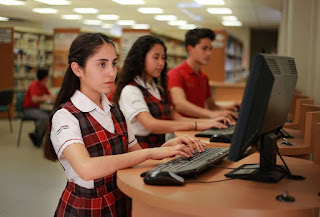 |
| How to Get a Student Visa for the USA in 2023: A Step-by-Step Guide |
Introduction:
Obtaining a student visa to study in the United States is a dream for countless international students. The U.S. offers world-class education, diverse cultural experiences, and endless opportunities. In this comprehensive guide, we'll explore how to get a student visa for the USA in 2023. We'll cover student visa requirements, the application process, interview tips, and common mistakes to avoid.
Student Visa Requirements for the USA
To begin your journey to study in the USA, it's crucial to understand the student visa requirements. These requirements serve as the foundation for your successful application. They include:
Acceptance by a U.S. Institution: First and foremost, you must secure admission to a U.S. educational institution. Make sure you have your acceptance letter on hand.
Form DS-160: Complete the online Nonimmigrant Visa Application form DS-160 and obtain the confirmation page with the barcode.
SEVIS Fee: Pay the Student and Exchange Visitor Information System (SEVIS) fee and obtain the receipt.
Valid Passport: Your passport should be valid for at least six months beyond your intended period of stay in the U.S.
Financial Proof: Demonstrate your ability to cover tuition, living expenses, and other related costs.
Visa Application Fee: Pay the non-refundable visa application fee.
Student Visa Application Process for the USA
The application process for a U.S. student visa can be intricate, but with careful planning and adherence to the following steps, it can be manageable:
1. Complete Form DS-160: Fill out Form DS-160 online. Ensure you have a passport-sized photo ready to upload.
The student visa application form (DS-160) can be found
here: https://travel.state.gov/content/travel/en/us-visas/visa-information-resources/forms/ds-160-online-nonimmigrant-visa-application.html
2. Pay the Visa Application Fee: Paying the visa application fee is a mandatory step. Keep the receipt as proof.
3. Schedule a Visa Interview: Create a profile on the U.S. Visa Information and Appointment Services website and schedule an interview at the U.S. Embassy or Consulate.
4. Gather Required Documents: Collect your acceptance letter, Form DS-160 confirmation, SEVIS fee receipt, passport, visa application fee receipt, and financial documentation.
5. Attend the Visa Interview: Dress professionally, be punctual, and confidently answer the consular officer's questions.
6. Biometric Data Collection: Some applicants may be required to provide biometric data.
7. Wait for Processing: After the interview, your visa will be processed. You may be required to submit additional documents or undergo administrative processing.
8. Visa Issuance: Once your visa is approved, you will receive it along with a visa stamp in your passport.
Student Visa Interview Tips for the USA
The student visa interview is a critical aspect of the application process. Here are some valuable tips to ensure success:
Be Prepared: Familiarize yourself with your application and supporting documents.
Communicate: Speak confidently and clearly, and be prepared to explain your study plans and reasons for choosing the U.S.
Be Honest: Always provide accurate and truthful information.
Show Ties to Your Home Country: Demonstrate strong ties to your home country to prove your intent to return after studies.
Dress Professionally: Make a good first impression by dressing appropriately.
Common Student Visa Mistakes to Avoid
To increase your chances of obtaining a U.S. student visa, it's important to steer clear of common mistakes:
1. Incomplete Documentation: Ensure all required documents are complete, accurate, and up-to-date.
2. Lack of Financial Proof: Failing to provide adequate financial documentation can lead to visa denial.
3. Inconsistent Information: Consistency in your application and interview responses is vital.
4. Insufficient Preparation: Inadequate preparation for the interview can result in a negative outcome.
5. Overconfidence: While confidence is essential, arrogance can be detrimental.
Conclusion:
Obtaining a student visa for the USA in 2023 is a significant milestone for international students. By understanding the requirements, following the application process diligently, acing the visa interview, and avoiding common mistakes, you can increase your chances of realizing your American dream. Remember, the key is to be well-prepared, honest, and confident throughout the process, making your journey to the USA smooth and successful.
FAQ - Frequently Asked Questions
1. What is the purpose of a U.S. student visa?
A U.S. student visa, often referred to as an F-1 visa, allows international students to pursue academic studies in the United States. It's specifically designed for individuals who wish to attend accredited U.S. colleges, universities, and language schools.
2. How early should I apply for a student visa in 2023?
It's recommended to start the application process at least 120 days before your intended start date, but not earlier. Be sure to check the specific requirements and processing times at the U.S. Embassy or Consulate in your home country.
3. What is the SEVIS fee, and how do I pay it?
The SEVIS fee is the Student and Exchange Visitor Information System fee, which funds the system that keeps track of international students in the U.S. You can pay the SEVIS fee online through the U.S. Immigration and Customs Enforcement (ICE) website.
4. Do I need to speak English fluently to get a U.S. student visa?
While a certain level of English proficiency is generally required, you don't need to be completely fluent. Most institutions may require you to take an English proficiency test, such as the TOEFL or IELTS, and meet specific score requirements.
5. Can I work on a U.S. student visa?
Yes, you can work in the U.S. on a student visa, but there are limitations. You can typically work on-campus part-time during the academic year and full-time during breaks. Off-campus employment opportunities are also available in certain situations.
6. Can I change my course or institution after getting a student visa?
Yes, you can change your course or institution in the U.S., but you must follow the proper procedures and maintain your F-1 status. Consult with your Designated School Official (DSO) for guidance on the process.
7. How long is a U.S. student visa valid?
A U.S. student visa is typically valid for the duration of your program of study. It can also include a 60-day grace period after the completion of your studies to prepare for departure or to pursue Optional Practical Training (OPT).
8. What happens if my U.S. student visa is denied?
If your visa is denied, the consular officer will provide a reason for the denial. You may be able to reapply, address the issues that led to the denial or seek legal advice for a review or appeal.
9. Is it possible to bring my family with me on a U.S. student visa?
In most cases, your spouse and unmarried children under 21 can accompany you to the U.S. on an F-2 visa. However, they won't be allowed to work in the U.S., and their visa status is dependent on your F-1 status.
10. What should I do if my passport expires while I'm studying in the U.S.?
It's essential to renew your passport at your country's embassy or consulate in the U.S. as soon as possible to maintain your immigration status. Notify your DSO about the passport renewal to update your records in SEVIS.
Remember, while this FAQ covers common questions about U.S. student visas, individual circumstances may vary, and it's advisable to consult with the U.S. Embassy or Consulate in your home country and your Designated School Official (DSO) for personalized guidance and the most up-to-date information.




Do leave your comments